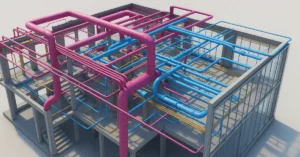How to Design a Mall as an Architect: The Art of Designing a Mall

Welcome to the world of mall architecture, where creativity meets commerce, and design shapes experiences. In this comprehensive guide, we’ll delve into the intricate process of designing a mall as an architect. From understanding user behavior to integrating sustainable practices, we’ll explore every aspect of mall design to create spaces that captivate, inspire, and endure.
Understanding the Mall Landscape:
Malls are more than just buildings; they’re vibrant ecosystems that cater to diverse needs and desires. Before diving into the design process, it’s crucial to understand the evolving landscape of malls. From traditional retail centers to mixed-use developments, each mall has its own identity and purpose. By analyzing market trends, demographic data, and consumer behavior, architects can gain valuable insights to inform their design approach.
The Power of Place-Making:
At the heart of mall design lies the concept of place-making – the art of creating spaces that evoke emotion and foster connection. By carefully curating architectural elements, landscaping features, and interior design aesthetics, architects can transform malls into destinations that resonate with visitors on a deeper level. Whether it’s through immersive theming, interactive art installations, or engaging public spaces, place-making sets the stage for memorable experiences.
Blending Form and Function:
Successful mall design strikes a delicate balance between form and function. While aesthetics play a crucial role in attracting visitors and creating a sense of identity, functionality is equally important for ensuring smooth operations and user satisfaction. Architects must consider factors such as spatial layout, traffic flow, accessibility, and zoning regulations to create malls that are both visually stunning and practical in use.
Embracing Sustainability and Wellness:
In an era of environmental consciousness and wellness awareness, sustainable design practices have become increasingly important in mall architecture. From energy-efficient building systems to green roofs and rainwater harvesting, architects have a myriad of tools at their disposal to minimize environmental impact and promote occupant well-being. By prioritizing sustainability and wellness, malls can not only reduce their carbon footprint but also create healthier, more resilient communities.
Designing for the Digital Age:
In today’s digital age, technology plays a significant role in shaping the mall experience. From mobile apps and digital signage to augmented reality and virtual shopping assistants, architects must consider how technology can enhance the overall user experience. By integrating smart building systems, interactive digital displays, and seamless connectivity, malls can create immersive environments that blur the lines between physical and digital realms.
Creating Memorable Retail Spaces:
Central to the success of any mall is its retail offering. As architects, our task is to design spaces that not only showcase products but also inspire exploration and discovery. By incorporating flexible floor plans, innovative merchandising strategies, and experiential retail concepts, architects can create retail environments that engage all the senses and drive foot traffic. From flagship stores to pop-up shops and curated marketplaces, the possibilities are endless.
Case Studies in Mall Design Excellence:
To illustrate these principles in action, let’s explore some real-world examples of mall design excellence:
- Mall of the Emirates, Dubai: With its iconic ski slope and luxury retail offerings, Mall of the Emirates has redefined the shopping experience in the Middle East.
- Westfield Century City, Los Angeles: By blending indoor and outdoor spaces, Westfield Century City has created a dynamic urban oasis that caters to modern lifestyles.
- Chadstone Shopping Centre, Melbourne: As the largest mall in the Southern Hemisphere, Chadstone Shopping Centre offers a seamless blend of fashion, dining, and entertainment in a contemporary setting.
Conclusion: Designing for the Future:
In conclusion, designing a mall is a multifaceted endeavor that requires creativity, innovation, and foresight. By understanding user needs, embracing sustainability, and leveraging technology, architects can create malls that are not only visually striking but also socially, environmentally, and economically sustainable. As we look to the future, let’s continue to push the boundaries of mall design, creating spaces that enrich lives, foster connections, and leave a lasting legacy for generations to come.
If you’re interested in learning more about architecture firms in Europe, check out this comprehensive list of the top 50 firms compiled by Archgyan. From innovative startups to long-established industry leaders, this list has it all. Take a look and discover some of the most inspiring and influential architecture firms in Europe today.
If you’re interested in architecture and want to learn more about this amazing field, subscribe to our podcast on youtube
For more SketchUp tutorials, head to https://www.sketchupguru.com










